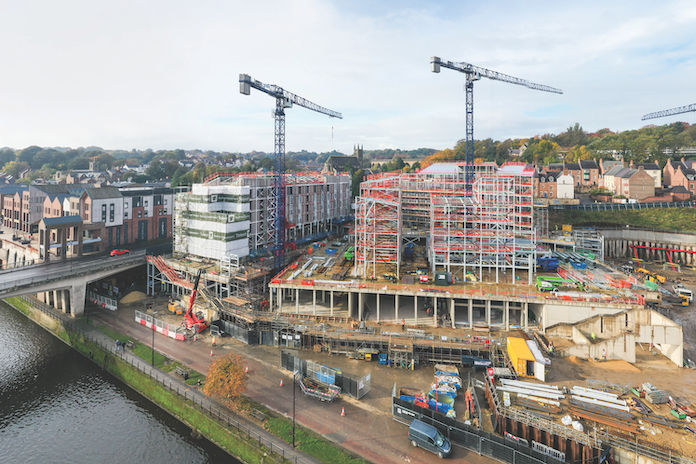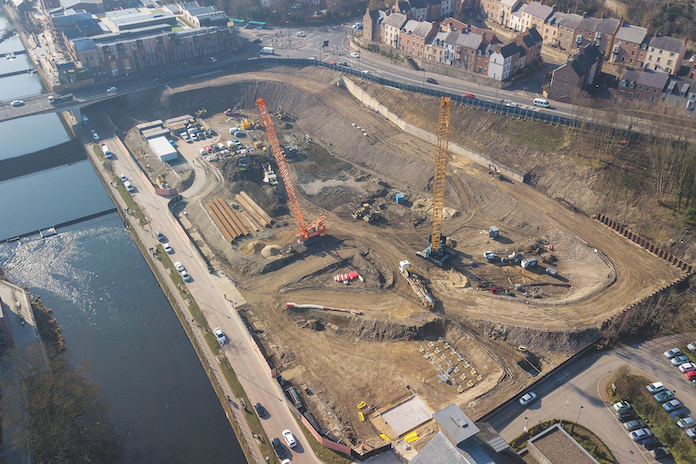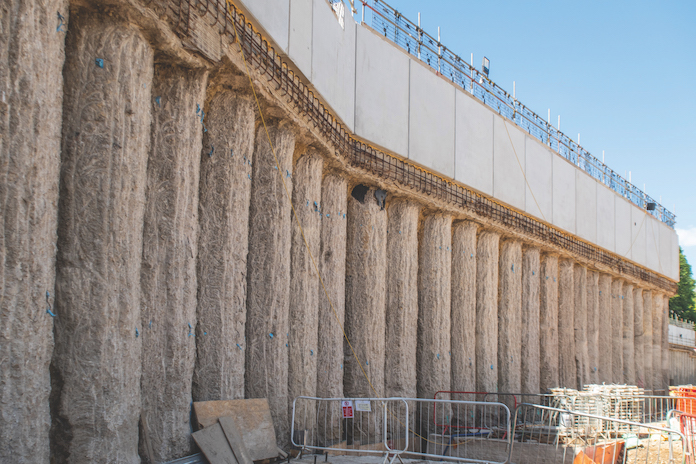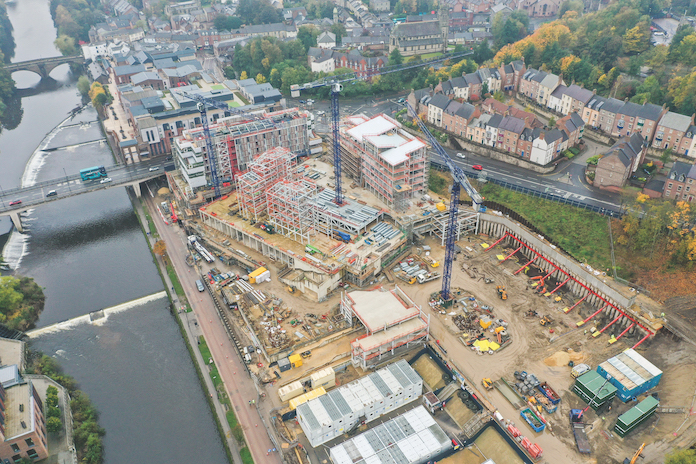
The superstructures of the retail units and hotel have now been finished
The giant Milburngate development on Durham’s riverside has required a complex infrastructure phase, including a monster retaining wall. Jamie Harris speaks to main contractor Tolent’s project manager
“On a project like this you become blasé about the normal challenges.”
Michael Rutherford is project manager for Tolent Construction on the 450,000 sq ft, £120m mixed-use Milburngate development in Durham. The north-east-based firm was appointed main contractor on phase one of the scheme at the beginning of 2019, which includes construction of 70% of the entire development, with the project commencing the following June.
Situated against a picturesque backdrop which includes Durham Castle and Durham Cathedral on the banks of the River Wear and located on a UNESCO World Heritage site, the scheme comprises a 92-bed hotel, 5,000 sq ft of speculative office space, three build-to-rent apartment blocks with 153 new homes, and 60,000 sq ft of retail space, including restaurants and a cinema.
The Milburngate development will sit proudly in the heart of the historic city centre’s landscape upon completion. And despite global pandemic-related setbacks for the sector, this project remains on track to meet its targeted finish date in November this year.

Groundworks required the use of the second-largest piling rig in the UK
Complex groundwork
The scale of the development is impressive, but it has also posed several technical and logistical challenges due to the compact nature and local geography of the site. The most demanding facet of the work has been the design and construction of a 236m-long, three-storey-high retaining wall which runs along the southern and western boundaries of the site.
The construction of the retaining wall was so complex that Tolent deemed the original solution unachievable at tender stage.
“The original programme, out of a 26-month project, required 14 months to build the retaining wall – but we got that down to 10 months,” explains Rutherford.

The 236m-long, three-storey-high retaining wall was the most demanding facet of the work
The complexity originates from the topography of the site. The wall twists and turns around the site boundary, and from west to east, the elevation difference is around 20m. Because of this, the wall is designed in 10 different clusters across the different directions and elevations. The team also needed to factor in a changing soil profile; housing was previously situated at the southern end, while a gas works used to sit at the northern end.
“The other thing to consider is that we’re also in a flood zone,” says Rutherford.
Sitting adjacent to the river, the project team faced a variable hydrogeology profile – the flow of groundwater at the site – which would impact how the piles for the retaining wall could be installed.
Rutherford’s team at Tolent, together with its subcontractors and specialists, including VolkerGround Engineering and BGP, engineered a solution which took each of these factors into account.
The numbers illustrate the sheer scale of the project. The wall required 20,000 cu m of concrete, with 1,500 CFA piles ranging from 350mm to 1,200mm in diameter – and with 164 of the larger piles installed to a depth of 25m.
“At that point,” explains Rutherford, “the piles were sufficiently strong enough to retain the bank side, but not with the water pressure included into it.”
As a result, the piles were installed with a 250mm gap between them in order to allow water to flow through and relieve any groundwater pressure on the retaining wall.
“The depth of the piles created its own problems with regard to the reinforcement cage lengths and how we get them down,” says Rutherford.
“We created a vibration plate to take the cages down, because once you drop them down about 20m, under their own weight, they tend to stick, so we have to vibrate them down into the cage for the last 4 or 5m.”
The reinforcement cages weighed up to 6 tonnes and measured 22m. Tolent believes that they are among the heaviest and longest CFA cages to ever be installed in the UK.
Besides the wall, there are another 1,700 ground-bearing CFA piles which support the main development. These range from 300m to 900mm and run to a depth of 12 to 20m.

Logistical issues
To complete this infrastructure work, Tolent required the use of the second-largest piling rig in the UK. The team deployed three piling rigs and a coring rig for nearly six months.
“Everybody is impressed at the design of the wall itself, but the logistics are just as significant,” explains Rutherford.
Procuring enough concrete to maintain the project’s piling programme became a major obstacle. There are limitations on heavy-duty vehicle (HDV) movements within the city centre for Tolent to comply with – a problem compounded by the World Heritage nature of the city. In addition, the sheer volume of concrete would be challenging to obtain locally.
“We would have taken up the entire 100% capacity of all three local concrete plants in the area,” says Rutherford. “They just weren’t going to do that.”
And even if Tolent was able to procure an adequate supply and adhere to vehicle movements, the speed of delivery would have an impact on the project team’s ability to install the cages.
“With the length of the cages, the slump of the concrete – the consistency of freshly made concrete – was significant. If it reduced, you simply wouldn’t get the cage in. If the vehicle got caught in traffic, time taken would allow the slump to slow down.”
The decision was made to place a concrete batching plant on site.
“We were producing anywhere between 160 to 200 cu m of concrete a day for a seven-month period,” says Rutherford.
Tolent estimates that this reduced HDV movements by up to 40% across the first nine months of the project – at its busiest point, the onsite plant kept one wagon load every 15 minutes off Durham’s roads.
“From an economical perspective, you need to be producing enough volume for an onsite concrete batching plant to be a viable option,” says Rutherford. “It doesn’t lend itself to a normal piling project.”
But the use of the plant next to the river added additional risks.
“We’ve had to create a space for a flood mitigation scheme,” explains Rutherford. “The original idea was to put the plant in this space, but there was a risk of getting contaminant into the river. We decided to flip our thinking; we placed all the site accommodation into this zone to eliminate this risk.”

Aerial view of the Milburngate site
Covid-19 impact
As with any active construction site working in 2020, Milburngate was also subject to covid-19 problems. Despite an initial slowdown in March, Rutherford says that the team was lucky to have avoided significant problems as work was still in its early stages.
“Covid didn’t hit us as hard this year because the work we were doing at the time was with the retaining wall. We were working outside and we were able to socially distance.”
Rutherford believes that this year could be more problematic, should restrictions continue to be enforced.
“By the middle of 2021 we will have a workforce of up to 450 people on site – we will have in excess of 1,000 individual rooms where people will be working in close contact with each other.
“The challenges also come with welfare facilities. People have to get washed, changed; they need somewhere to sit and eat. We have tripled the size of our facilities to accommodate this increase in workforce in the new year.”
With the completion of the retaining wall in mid-2020, Tolent began work on the superstructures of the development. The podium holding the retail units has been completed, while work on the residential building structures has begun. The steelwork of the hotel is also complete, allowing internal work to begin.
Phase two of the development, involving three office blocks, is due to go out to tender later this year.

CGI showing how the completed development will look
Project team: Milburngate Phase One
- Client: MGH CARD LLP
- Client and project architect: FaulknerBrowns Architects
- Main contractor (shell and core): Tolent Construction
- Structural engineering: Atkins / Billinghurst George & Partners
- Value: £84.5m
- Programme: 128 weeks
- Contract: Design and build
- Subcontractors:
- Groundworks: Wyn Construction
- Steelwork: Finley Structures
- Building services: SES










